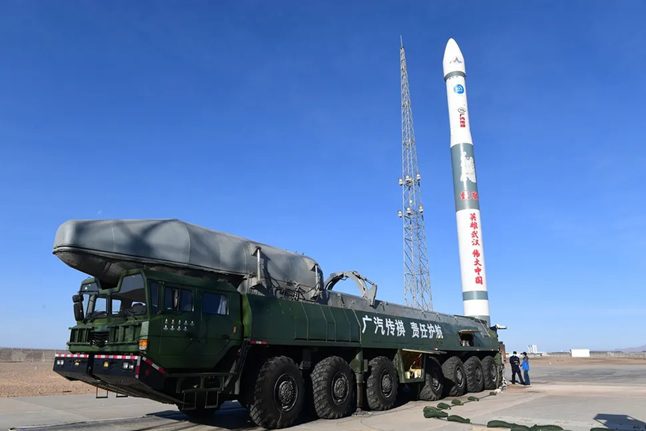While many have concerns over the Orwellian prospect of being spied on by our own appliances ranging from smart televisions to more bizarrely, sex aids, the “Internet of Things” was viewed as a positive development by the leaders of satellite operators at the Satellite 2017 conference held in Washington DC in March. For connectivity was the watchword of the conference attended by most of the world’s commercial satellite communications firms.
Connectivity for trains, planes and automobiles needs mobile satellite constellations
Josh Menk of the airline communications provider, Global Eagle, similarly saw end-to-end connectivity of such mobile devices as being a major part of the communications satellite business in the future, but warned that this might not need as much satellite capacity as some expect. High Throughput Satelites (HTS) in offering up to 50Gbps are reducing the cost per bit of capacity, however they do still suffer from signal delay (latency) which low Earth constellations would solve.
Menk’s opinion was conservative relative to that of Eric Beranger, CEO of LEO constellation Oneweb who noted that the “Internet of Everything” would be the driving force for the new LEO constellations.
Nevertheless, even he accepts that there still remains a scepticism over the size of some of the constellations being proposed, including a follow-on one for OneWeb which would run into thousands of satellites. Such constellations promise capacities of terabits per second.
Later in the conference Daniel S. Goldberg of Telesat reiterated the point that low cost per bit and low latency was what customers wanted, the later reason and the move by Intelsat to take over OneWeb reinforcing his firm’s decision to start an LEO constellation.
Rupert Pierce of Inmarsat noted that “cellular does not cut it” in conjunction with the data usage needed by autonomous cars and that satellites would have to be used.
Kymeta struck a deal with Intelsat/OneWeb to offer their antennas for the KALO network with Intelsat taking an equity stake in Kymeta. Not to be outdone, Hughes Network Systems/Echostar, having earlier demonstrated the speed of their current mobile network, formally announced a new commercial aviation internet system in conjuction with SES. The system would initially use Ka-band transponders on Echostar 17, Echostar 19 with AMC-15 and AMC-16. The partnership has already signed an airline customer – as yet unnamed.
The difference between this and the past failed Boeing attempt at internet connectivity “Connexion” is that there is increasing demand to use “smart phones” on aircraft using a local Wifi-serviced by a satellite internet system.
Steve Collar of O3B warned that limited launch availability could also slow the deployment of the low Earth orbit constellations, with all that would mean for loan repayments. Nevertheless, this warning triggered Scott Sprague of OneWeb to reassure the audience that his constellation would be operationally deployed on time by 2020.
Of course, constellations themselves are both at risk from, and a potentially cause of the hazard of space debris. Iridium CEO Matt Desch, one of whose satellites was subject to a satellite strike, specifically warned of the risk of failed satellites. That is, it was not enough to put in place retirement protocols to remove satellites as inoperative failed satellites could not hope to comply.
It was generally accepted by the panellists discussing low Earth orbit constellations that they have many regulatory and coordination hurdles to get over before they are deployed and that the International Telecommunications Union (ITU) is more experienced in regulating GEO systems.
Satellite manufacturers: young engineers should not be held back
Apart from the usual moans about launch delays, the manufacturers led by Boeing Satellite System’s President Mark Spiwak, agreed that reliability and affordability had to be balanced for a successful system.
Paul Estey of Space Systems Loral wondered openly whether future communications satellites may just be the holder of an interchangeable communications payload for satellites in geostationary Earth orbit (GEO).
While the subject of losing know how came up later in the launch providers’ presentations, Mark Van Schaik of Thales Alenia Space was more concerned that innovation and new ideas might be curtailed by young engineers being strangled by the current thinking and regime of a firm. That is, new engineers should be given more freedom to think and work.
Insurance: Low flight rate affects premium levels
Of course, launches provide a staple diet of premiums for underwriters. However, delays can also starve them. This year’s launch hiatuses by Proton and Falcon 9, when combined with very low rate levels, meant that premiums were at their lowest for 15 years. Chris Kundstadter, space underwriter at XL Catlin was also worried that such was the value of satellites being flown that there were now accumulations of risk being flown on single dual launches. He mentioned that one flying later this year would have an insurance value in total of US775 million – historically the largest ever launch risk ever covered.
With respect to new satellite technology and new launch vehicles Kundstadter said that underwriters would continue to cover it “as long as we understand it.” He did however see the benefit of standardisation across the industry for technical items such as digital payloads as it made them simpler to assess.
Launch providers: Back up agreements may return while India is seen as a driver not a threat
Clay Mowry of new launch provider Blue Origin noted, when it came to new electric thruster technology allowing slow but fuel efficient orbit raising and final positioning, that the mass saving of such systems was not going towards building smaller satellites, but rather larger ones with much communications payload capacity.
It is not just on Earth that the firm is planning its business. Blue Origin is planning a new “Blue Moon” lunar cargo delivery service.
Mowry was in town to oversee his boss’s announcement of new contracts with Eutelsat and OneWeb for the firm’s New Glenn launch vehicle. Bezos had indicated in his speech that he wanted to reuse his rocket’s first engines by up to 100 times.
Kirk Pysher has had a torrid time as the relatively new head of International Launch Services. Pysher has had to watch his Proton rocket’s stand idle while a launch anomaly was investigated. However, Pysher explained that this really was a good sign of a new seriousness in the Russian space industry in tackling their quality control problems. On the latest engine fault issue which was traced to the wrong solder being used for a braising operation, he mentioned that faulty solder had been used because a workman had not wanted to take it home and be thought of as a thief. So he put it back in the store room but in the wrong location from where it was taken and used incorrectly.
Pysher does at least have something to look forward to with the first launch of the Proton Medium next year and a new 5m faring debuting in 2020. He also has a smaller LEO capable rocket in the form of the Angara 1.2 coming up to operational status.
Gwynne Shotwell, President and COO of SpaceX, noted that the firm was striving to serve its already very full manifest, in addition to making new eye-catching flights carrying tourists around the Moon. The firm is planning its first reuse of a pre-flown first stage on a Falcon 9 launch later this year (carrying an SES payload) along with five other “re-used stage” flights. Shotwell also noted that the firm was testing the new rocket engine eventually intended for a Mars rocket.
With respect to SpaceX’s (and Blue Origin’s) planned use of reusability, Rupert Pierce of Inmarsat noted that he wanted no hold ups in the flight schedules and more choice of launchers.
While his firm’s Atlas rockets might not be the cheapest, Steve Skiadaneke of Lockheed Martin Commercial Launch Services noted that clients wanted “Date certainty and mission reliability” above all. Skiadanek did say that the plan to market the Athena low Earth launch veheicle was effectively being stood down though it technically was still available.
When asked which rocket other than SpaceX’s she most admired Gwynne Shotwell said the Soyuz due to its longevity and reliability. Shotwell also noted that the head of her firm’s competitor Arianespace’s, Stephane Israel was an example of rocket guy winning a satellite show’s space executive of the year award.
Simplicity was the word for Ko Ogasawara who represented MHI. He noted that the expander cycle of the H-3’s new engine dramatically reduced its part count, while its lack of gimballing made it even simpler.
With respect to this year’s launch delays, both Gwynne Shotwell and Kirk Pysher both foresaw more back-up cooperation between launch providers in finding a ride for satellites in the event of long launch delays much as the airlines did for passengers in the 1960s.
Like the satellite manufacturers, launch providers remain concerned about experienced engineers leaving the profession. Steve Skiadanek was concerned that knowledge and know-how was not being maintained in the launch profession as older generations retired.
Launch sites: Congestion awaits
With respect to where new rockets can fly from, Jim Ball of Space Port Solutions while talking on the space ports panel noted that the Florida Space Port was going to get very busy. He presented a slide showing just how many users were going to use the facilities at both Cape Canaveral and Kennedy Space Centre. His prediction was that they may be 100 to 200 launches per year from this area, and with reusable first stage landings, this might equate to up to 400 “operations” which could become a congestion threat.
The cost of launches still concerns some – especially as mass manufacture of large constellations means that their construction price is now likely to be significantly less than the launch costs. For example, Charles Miller, President of Next Generation Space/Nanoracks noted that OneWeb spacecraft were likely to cost US$500,000 each to build but would cost US$1.5 million each to launch. Miller foresaw launch costs actually hindering the financial viability of some constellations.
His solution was Ultra Low Cost Access to Space (ULCATS) systems which would lower the cost of launches by upto three times in the next ten years and would be ten times lower in the following decade.
When it came to the threat of third party nations such as India managing to launch cheaper that US systems using its expendable PSLV, there is little appetite at least in the industry for making restrictions on them. Lieutenant Colonel Thomas Schilling, USAF saw this competition as a driver for their own efforts in reusable technology. Charles Miller agreed noting that India might force progress. Jim Ball said “We must avoid the self-inflicted wounds (of protectionism).”
Jim Ball noted that the industry needed “adaptive capacity” to cope with market changes in the case of new foreign competition or if the new LEO communications constellations succeed or not. Ball further noted that spaceports had to make sure that they were not the reason any restrictions happened, and that control by individual states, rather than by FAA federal control was more agile in dealing with situations.
Exhibition: new antennas catch the eye
The exhibition at Satellite 2017 was very large with all of the major satellite companies represented. There were also smaller firms showing off their ideas. Sometimes it was a surprise just how far some of them had come. Orbital ATK’s models of its GEOStar satellite range showed how the design had grown.
This included a small antenna construction firm from Israel called NSL. Their idea was to use new shaped memory polymer antennas in conjunction with Adaptive subreflectors to allow footprint shaping and antenna corrections. Their technology is scalable from 60 cm devices for cubesat to 5 m types for use by Geostationary communications satellites.
In the field of ground antennas, Kymeta was showing off its new 60 cm phased array device for mobile use. It is an active antenna so would require a power source but could be used on road vehicles. Kymeta is to use this technology as part of its cooperative partnership with Intelsat/OneWeb as part of the KALO network which uses Intelsat (and eventually OneWeb) bandwidth in conjuction with Kymeta’s antennas. Kymeta admits that car manufacturers want smaller antennas than this with 20 cm being suggested by Toyota.





